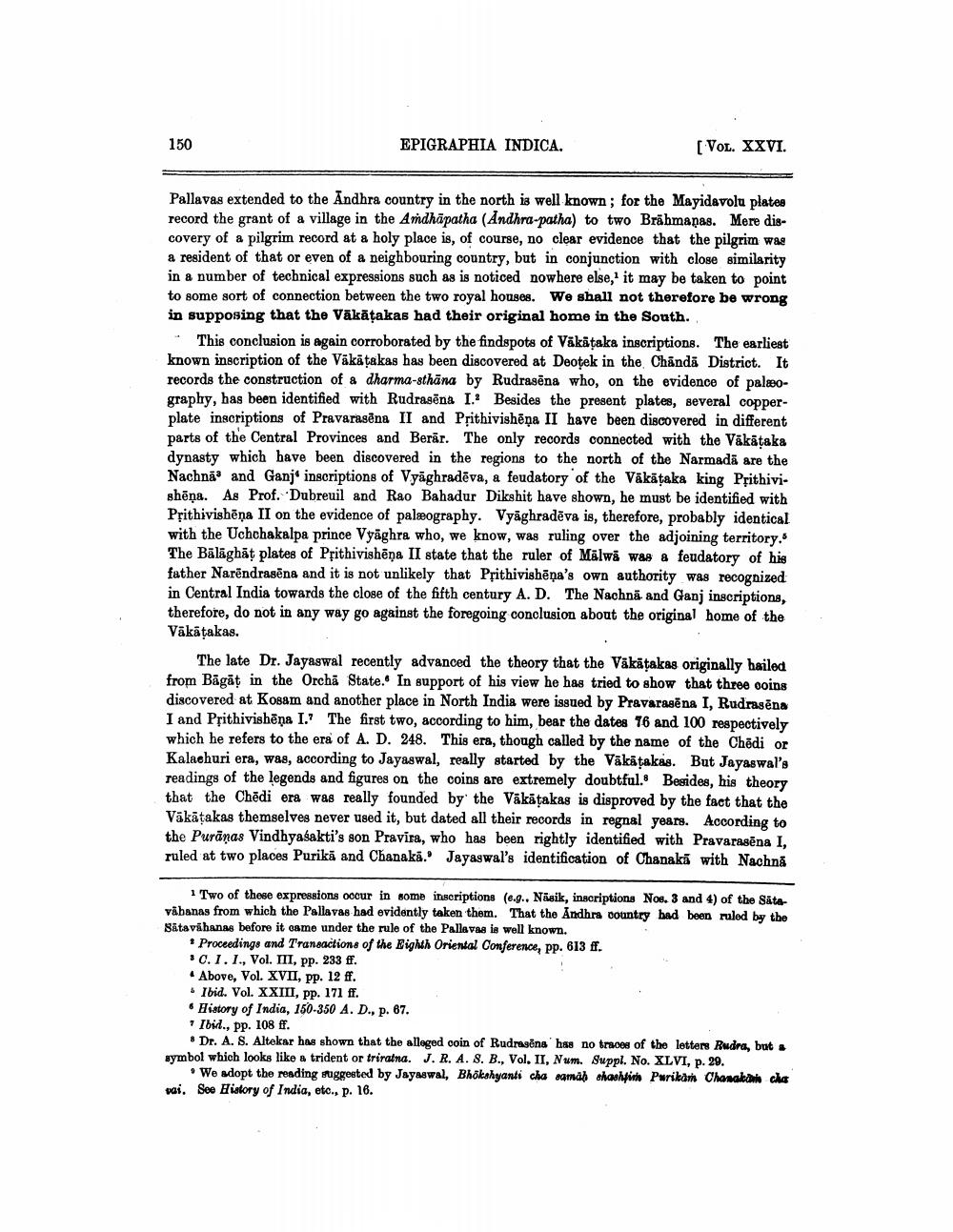________________
150
EPIGRAPHIA INDICA.
[Vol. XXVI.
Pallavas extended to the Andhra country in the north is well known; for the Mayidavolu plates record the grant of a village in the Ardhāpatha (Andhra-patha) to two Brähmaņas. Mere discovery of a pilgrim record at a holy place is, of course, no clear evidence that the pilgrim was a resident of that or even of a neighbouring country, but in conjunction with close similarity in a number of technical expressions such as is noticed nowhere else, it may be taken to point to some sort of connection between the two royal houses. We shall not therefore be wrong in supposing that the Vākāțakas had their original home in the South.
- This conclusion is again corroborated by the findspots of Väkätaka inscriptions. The earliest known inscription of the Väkäţakas has been discovered at Deotek in the Chandi District. It records the construction of a dharma-sthāna by Rudrasēna who, on the evidence of palæography, has been identified with Rudrasēna I. Besides the present plates, several copperplate inscriptions of Pravarasēna II and Prithivishēņa II have been discovered in different parts of the Central Provinces and Berār. The only records connected with the Vākātaka dynasty which have been discovered in the regions to the north of the Narmadā are the Nachna and Ganj inscriptions of Vyāghradēva, a feudatory of the Väkātaka king Prithivishēņa. As Prof. Dubreuil and Rao Bahadur Dikshit have shown, he must be identified with Prithivishēna II on the evidence of palæography. Vyāghradēva is, therefore, probably identical with the Uchchakalpa prince Vyaghra who, we know, was ruling over the adjoining territory. The Bālāghāt plates of Prithivishēna II state that the ruler of Mälwi was a feudatory of his father Narēndrasēna and it is not unlikely that Prithivishēņa's own authority was recognized in Central India towards the close of the fifth century A. D. The Nachnă, and Ganj inscriptions, therefore, do not in any way go against the foregoing conclusion about the original home of the Vākatakas.
The late Dr. Jayaswal recently advanced the theory that the Vákatakas originally hailed from Bāgāt in the Orcha State. In support of his view he has tried to show that three coins discovered at Kosam and another place in North India were issued by Prevarasēna I, Rudrasēna I and Prithivishēna I. The first two, according to him, bear the dates 76 and 100 respectively which he refers to the era of A. D. 248. This era, though called by the name of the Chēdi or Kalashuri era, was, according to Jayaswal, really started by the Vākätakas. But Jayaswal's readings of the legends and figures on the coins are extremely doubtful. Besides, his theory that the Chēdi era was really founded by the Vākāțakas is disproved by the fact that the Vākātakas themselves never used it, but dated all their records in regnal years. According to the Puranas Vindhyasakti's son Pravira, who has been rightly identified with Pravarasēna I, ruled at two places Purikā and Chanakā.' Jayagwal's identification of Chanaka with Nachná
1 Two of these expressions occur in some inscriptions (e.... Näsik, inscriptions Nos. 3 and 4) of the Sāta yabanas from which the Pallavas had evidently taken them. That the Andhra country had been ruled by the Satavahanas before it came under the rule of the Palla vas is well known.
* Proceedings and Transactions of the Eighth Oriental Conference, pp. 613 ff. *C.1.1., Vol. II, pp. 233 ff. . Above, Vol. XVII, pp. 12 ff. • Ibid. Vol. XXIII, pp. 171 ff.
History of India, 150-350 A. D., p. 67. * Ibid., pp. 108 ff.
• Dr. A. S. Altekar has shown that the alleged coin of Rudrasena has no traces of the letters Rudra, bat. symbol which looks like a trident or triratna. J. R. A. 8. B., Vol. II, Num. Suppl. No. XLVI, p. 29.
We adopt the reading suggested by Jayaswal, Bhõkshyanti cha samah shoshino Pwrikan Chanakini cha vai. See History of India, etc., p. 16.




